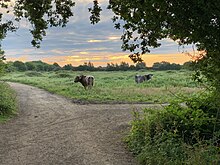Knepp Castle

The medieval Knepp Castle (sometimes referred to as 'Old Knepp Castle', to distinguish it from the nearby nineteenth century mansion) is to the west of the village of West Grinstead, West Sussex, England near the River Adur and the A24 (grid reference TQ163209). The name is thought to come from the Old English word "cnæp", referring to the mound on which it stands.[1] The land around the castle is now the site of Knepp Wildland.
History
The castle was originally a motte and bailey fortress, built in the 12th century by William de Braose. It was rebuilt as a stone castle with a two-storey keep in 1214 by King John. In addition to John the castle had a succession of royal visitors, including Henry III in 1218, Edward II in 1324 and Richard II in 1384. Subsequently, it fell into decline and deteriorated. The bulk of it had been destroyed by the 1720s. In the early 19th century the remnants were reinforced and fenced in by Sir Charles Burrell to protect them from further deterioration.

The castle stands on an oval mound, modelled from a natural feature, surrounded by a ditch and ramparts. The ditch, fed from a nearby pond, formed a moat which still contained water at the beginning of the eighteenth century.[1]
The surviving remains of the castle consist of a single wall 11 metres high, 9.5 metres long, and 2.5 metres thick, with a doorway and another opening above it. This wall apparently formed the north end of the west wall of a tower or keep.[1]
The name 'Knepp Castle' is also applied to the castellated Gothic Revival mansion built nearby in the early nineteenth century by Sir Charles Merrik Burrell, to the designs of John Nash,[2] and currently the home of Sir Charles Burrell, 10th Baronet.
Knepp Wildland

The land around the castle is now the site of Knepp Wildland, the first large-scale rewilding project in England, created from 1,400 hectares or 3,500 acres of former arable and dairy farmland owned by Charles Burrell.[3]
References
- ^ a b c A P Baggs; C R J Currie; C R Elrington; S M Keeling; A M Rowland (1986). T P Hudson (ed.). "Shipley: Knepp Castle". A History of the County of Sussex: Volume 6 Part 2: Bramber Rape (North-Western Part) including Horsham. Institute of Historical Research. Retrieved 28 July 2011.
- ^ Historic England. "Details from listed building database (1354214)". National Heritage List for England. Retrieved 28 July 2011.
- ^ "Rewilding revives a country estate". Financial Times. 28 September 2018.
External links
- Knepp Castle Estate
- Fry, Plantagenet Somerset, The David & Charles Book of Castles, David & Charles, 1980, p. 250. ISBN 0-7153-7976-3
